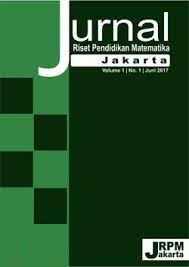Desain Pembelajaran Segi Empat dengan Pendekatan RME Pada Siswa SMP
Desain Pembelajaran Segi Empat dengan Pendekatan RME
DOI:
https://doi.org/10.21009/jrpmj.v4i1.23028Keywords:
STEM, PjBL, Number PatternAbstract
The importance of STEM education has been recognized for preparing diverse students to cultivate future job opportunities in STEM, and for a nation as a whole for technological innovation and national prosperity and security (Li, Schoenfeld, Disessa. 2019). The STEM approach requires the right learning model to be able to achieve learning objectives. One of the learning models that can be used with STEM is PjBL (Project Based Learning). Project-Based Learning (PjBL) is a learning model that teaches concepts in the curriculum through a student-centered project so that they can work autonomously, collaboratively and through assignments. STEM (Science, Technology, Engineering and Mathematics) is learning that integrates the concepts of science, technology, engineering and mathematics. Students are able to apply STEM knowledge practically and produce meaningful learning through PjBL activities. Combining PjBL with STEM has an influence on students' attitudes towards future career pursuits (Tseng, Chang, Lou, Chen. 2013).
References
Basuki, Imam. 2014. Kemauan Berjalan Kaki Penumpang Angkutan Perkotaan (Studi Kasus Penumpang Angkutan Perkotaan di Yogyakarta). The 17th FSTPT International Symposium, Jember University.
Cahyadi, Alifan. 2016. Perencanaan Desain Fasilitas Pejalan Kaki yang Terintegrasi dengan Kantong Parkir dan Halte Bus Kampus di Lingkungan Kampus UGM. Yogyakarta: s.n.
Direktorat Aset. 2017. Luas Lahan Seluruh Kantong Parkir UGM. Yogyakarta: Universitas Gadjah Mada.
Direktur Jenderal Perhubungan Darat. 1998. Pedoman Teknis Penyelenggaraan Fasilitas Parkir. Jakarta: Departemen Perhubungan.
Institute for Transportation & Development Policy. 2014. TOD Standard 2.1. New York: Despacio.
Keselamatan Kerja dan Lingkungan. 2018. Data Fluktuasi Penggunaan Kantong Parkir Bulan April. Yogyakarta: PK4L UGM.
Munawar, A. 2004. Analisis Jaringan Transportasi di Kampus UGM. Yogyakarta. Media Teknik.
Munawar, A., 2004, Manajemen Lalulintas Perkotaan, Beta Offset. Yogyakarta.
Setiawan, Rudy. 2007. Penerapan Manajemen Transportasi Kampus Sebagai Upaya Mengurangi Penggunaan Mobil (Studi Kasus Universitas Kristen Petra). Surabaya: s.n.
Sudjarwadi. 2009. UGM Jadi Kampus “educopolis”. Antaranews.com.




